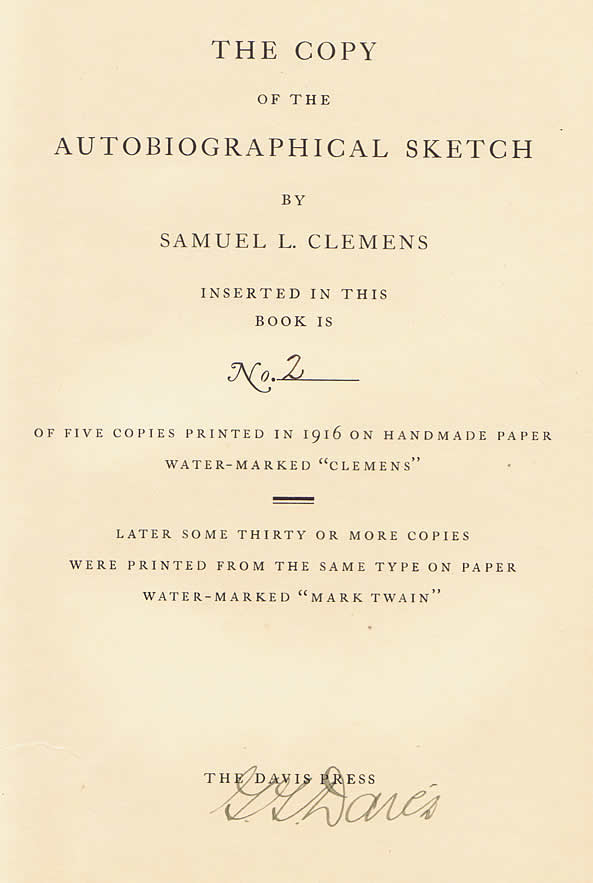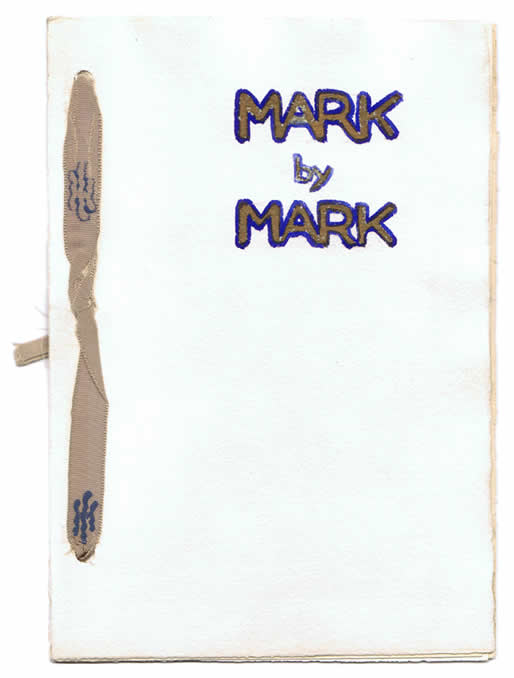| Born In Florida, Mo., Nov. 30th, 1835. Son of John Marshall Clemens,
of Virginia, and Jane Lambton, of Kentucky. An ancestor (Jeoffrey Clement),
was ambassador to Spain under Charles I., married a Spanish wife and introduced
a strain of Spanish blood into the Clemens stock, which shows up now and
then in a descendant yet. (Clara is an instance.) This Clement sat as
one of Charles's judges on the trial that rendered the death verdict.
The Lambtons still possess in England the lands occupied by their ancestors
of the same name before the invasion of the Conqueror.
The childhood of S. L. Clemens was spent in the village of Florida,
his boyhood in the town of Hannibal, on the Mississippi. Before he was
thirteen he had been rescued in a substantially drown condition nine
times -- three times from the Mississippi and six times from Bear Creek.
His mother's comment was: "People who are born to be hanged are
safe in the water."
S. L. Clemens's parents began their young married life in Lexington,
Ky., with a small property in land and six inherited slaves. They presently
removed to Jamestown, Tennessee; later to Florida, Mo., and finally
to Hannibal, where Mr. Clemens served as a magistrate some years and
was then elected County Judge, but died (1847) before he was invested
with the office.
S. L. Clemens was educated in the common school at Hannibal, and in
his brother's newspaper office, where he served in all capacities, including
staff work. His literature attracted the town's attention, "but
not its admiration" -- (his brother's testimony).
He ran away in 1853 and visited the World's Fair in New York. After
a year's absence in the Atlantic States he was obliged by financial
stress to reveal his whereabouts to the family. He returned to the West
and lived in St. Louis, Muscatine, and Keokuk until 1857; he spent the
next four years on the river between St. Louis and New Orleans, in the
pilot house.
He was in New Orleans when Louisiana went out of the Union, January
26, 1861, and started North the next day. Every day on the trip a blockade
was closed by the boat, and the batteries at Jefferson Barracks (below
St. Louis), fired two shots through her chimneys the last night of the
voyage.
In June he joined the Confederates in Ralls County, Mo., as a second
lieutenant, under General Tom Harris, and came near having the distinction
of being captured by Colonel Ulysses S. Grant. He resigned, after two
weeks service in the field, explaining that he was "incapacitated
by fatigue" through persistent retreating; became private secretary
to his brother, who had been appointed Secretary of the new Territory
of Nevada, and crossed the plains with him in the overland coach-an
eighteen day and night trip.
After a year spent in the silver mines of the Humboldt and Esmeralda
regions he became local editor of the "Territorial Enterprise,"
at Virginia, Nevada, and also legislative correspondent for that paper
from Carson City, the capital. He wrote a weekly letter to the paper;
it appeared Sundays, and on Mondays the legislative proceedings were
obstructed by the complaints of members, as a result. They rose to questions
of privilege and answered the criticisms of the correspondent with bitterness,
customarily describing him with elaborate and uncomplimentary phrases,
for lack of a briefer way. To save their time, he presently began to
sign the letters, using the Mississippi leadsman's call, "Mark
Twain," (2 fathoms -- 12 feet) for this purpose.
Dueling was in that day a custom there -- a temporary one. The weapons
were always Colt's navy revolvers; distance, fifteen paces, fire, and
advance; six shots allow. Mark Twain and Mr. Laird, editor of the Virginia
"Union," got into a newspaper quarrel and a duel was appointed
for dawn in a mountain gorge outside the town. Neither man was capable
with a pistol; but this did not appear on the field, for an accident
caused Mr. Laird to withdraw and apologise. The accident was this. The
seconds of both parties were practicing their men in neighboring gorges
with a concealing ridge between. Mr. Laird was making fairly good practice,
but Mark Twain was hitting nothing. A small bird flew by and lit on
a sage bush thirty yards away, and Mark Twain's second who was an expert,
fired and knocked its head off. Just then the adverse , party came over
the ridge to compare notes, and when they saw the dead bird and learned
the distance, they were interested. When they further learned erroneously
(from Gillis, Mark Twain's second) that Twain had done the shooting,
and that it was not a remarkable feat for him, they were troubled. They
drew aside and consulted, then returned and made a formal apology and
the duel was "off."
There was a new and stringent law which provided two year's imprisonment
for any one who should send a challenge, carry a challenge, or receive
one. The noise of the proposed duel had reached the capital, eighteen
miles distant. Governor North was very angry and gave orders for the
arrest of all concerned in the preliminaries of the duel; he said he
would make an example that would be remembered. But a friend of the
duelists got wind of the matter and outrode the officers of the law,
arriving in time to hurry the parties over the frontier into California
and save them from well-earned punishment.
Mark Twain took service of the San Francisco "Morning Call"
as city editor, and held the place a couple of years; then spent three
months in the "pocket" mines of Calaveras County at Jackass
Gulch, but found no pockets.
He returned to San Francisco and wrote letters to the Virginia "Enterprise"
for a while, and was then sent to the Sandwich Islands by the Sacramento
"Union" to write about the sugar interest. While in Honolulu
the survivors of the Clipper "Hornet" (burned on the line)
arrived, mere skin and bone relics, after a passage of forty-three days
in an open boat on ten day's provisions, and Mark Twain worked all day
and all night and produced a full and complete account of the matter
and flung it aboard a schooner which had already cast off. It was the
only full account that went to California, and the "Union"
paid Mark Twain ten-fold the current rates for it.
On his return to California after a half-year's absence, he profitably
delivered several lectures and then went east, 1867, and joined the
"Quaker City" Excursion to Europe and the Holy Land; was gone
five or six months, and upon his return wrote and published "The
Innocents Abroad," 1869, which was an account of the voyage. The
sale reached 100,000 copies in the first year, and doubled it later.
In 1869 he entered the lecture field and traversed the eastern and
western states. Remained in the field four years.
In the beginning of February, 1870, he was married to Miss Olivia L.
Langdon, and took up his residence in Buffalo, N. Y., where he bought
a third interest in the "Express," a daily newspaper, and
joined its staff. In the following November a son (Langdon) was born
to him. (Died 1872.)
In October 1871 he removed to Hartford, Conn., and presently built
a house, which the family still retain.
In 1872 Susan Olivia Clemens was born. "Roughing It" written.
Also "The Gilded Age" (in collaboration with Charles Dudley
Warner).
In 1873 the family spent some months in England and Scotland; Mark
Twain lectured a few weeks in London.
In the succeeding years various books were written In 1874 Clara Langdon
Clemens was born. In 1878 the family went to Europe and spent eighteen
months. "A Tramp Abroad" resulted. Jean Clemens born, 1880.
In 1885 Mark Twain financed the publishing house of Charles L. Webster
& Co., in New York. Its first issue was the Memoirs of General Grant,
which achieved a sale of more than 600,000 volumes. The first check
received by the Grant heirs was for £200,000. It was followed
a few months later by a check for $150,000. These are the largest checks
ever paid for an author's work on either side of the Atlantic.
In 1886-89 Mark Twain spent a large sum of money on a type-setting
machine which was a failure. The money was all lost. The publishing
house was incapably conducted, and wasted all the money that came into
its hands. Mark Twain contributed $65,000 in efforts to save its life,
but to no purpose. It finally failed (1894) with liabilities of $96,000
and assets worth less than a third of that amount. The privilege of
paying the debts fell to Mark Twain's share.
In 1895-96 Mark Twain, with his wife and second daughter, made a lecturing
tour around the world, wrote "Following the Equator," and
paid off the debts.
Near the close of this absence of thirteen months, the eldest daughter,
who had remained, at home, died, aged twenty-four years.
The years of 1897-98-99 were spent by the family in England, Switzerland
and Austria. Mark Twain was present in the Austrian Reichsrath on the
memorable occasion when the House was invaded by sixty policemen and
sixteen refractory Members dragged roughly out of it.
A number of his books have been translated and published in France,
Germany, Russia, Italy, Sweden, Norway and Hungary.
Dramatizations of the "Gilded Age," "Tom Sawyer,"
"Prince and Pauper," and "Pudd'nhead Wilson" made
good successes on the stage.
|



